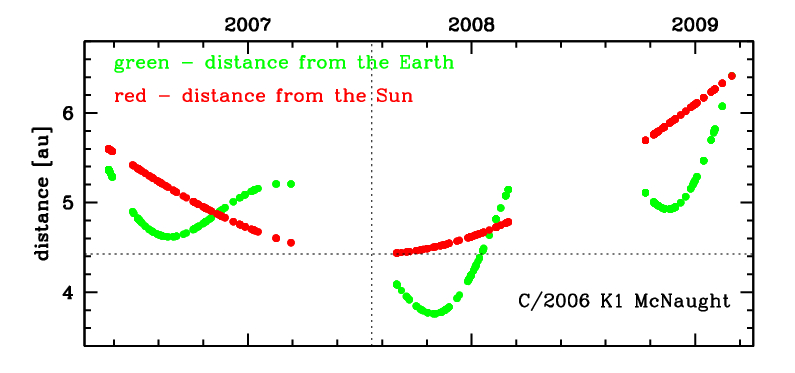C/2006 K1 McNaught
more info
C/2006 K1 was discovered on 17 May 2006 by Robert H. McNaught on the Siding Spring Survey images taken with the 0.5-m Uppsala Schmidt telescope [IAUC 8712, 2006 May 18].
This comet made its closest approach to the Earth on 30 October 2007 (3.761 au), 3.3 months after perihelion.
Solution given here is based on data spanning over 2.8 yr (3 oppositions) in a range of heliocentric distances: 5.60 au – 4.426 au (perihelion) – 6.41 au.
This Oort spike comet suffers moderate planetary perturbations during its passage through the planetary system that lead to escape of the comet from the solar system on hiperbolic orbit (see future barycentric orbit).
See also Królikowska 2014 and Królikowska and Dybczyński 2017.
This comet made its closest approach to the Earth on 30 October 2007 (3.761 au), 3.3 months after perihelion.
Solution given here is based on data spanning over 2.8 yr (3 oppositions) in a range of heliocentric distances: 5.60 au – 4.426 au (perihelion) – 6.41 au.
This Oort spike comet suffers moderate planetary perturbations during its passage through the planetary system that lead to escape of the comet from the solar system on hiperbolic orbit (see future barycentric orbit).
See also Królikowska 2014 and Królikowska and Dybczyński 2017.
| solution description | ||
|---|---|---|
| number of observations | 417 | |
| data interval | 2006 05 17 – 2009 02 28 | |
| data type | perihelion within the observation arc (FULL) | |
| data arc selection | entire data set (STD) | |
| range of heliocentric distances | 5.6 au – 4.43 au (perihelion) – 6.41 au | |
| detectability of NG effects in the comet's motion | NG effects not determinable | |
| type of model of motion | GR - gravitational orbit | |
| data weighting | YES | |
| number of residuals | 829 | |
| RMS [arcseconds] | 0.47 | |
| orbit quality class | 1a+ | |
| orbital elements (heliocentric ecliptic J2000) | ||
|---|---|---|
| Epoch | 2007 08 08 | |
| perihelion date | 2007 07 20.55099100 | ± 0.00034700 |
| perihelion distance [au] | 4.42551584 | ± 0.00000227 |
| eccentricity | 1.00147580 | ± 0.00000414 |
| argument of perihelion [°] | 296.442241 | ± 0.000042 |
| ascending node [°] | 72.114889 | ± 0.000010 |
| inclination [°] | 53.876951 | ± 0.000009 |
| reciprocal semi-major axis [10-6 au-1] | -333.47 | ± 0.93 |
